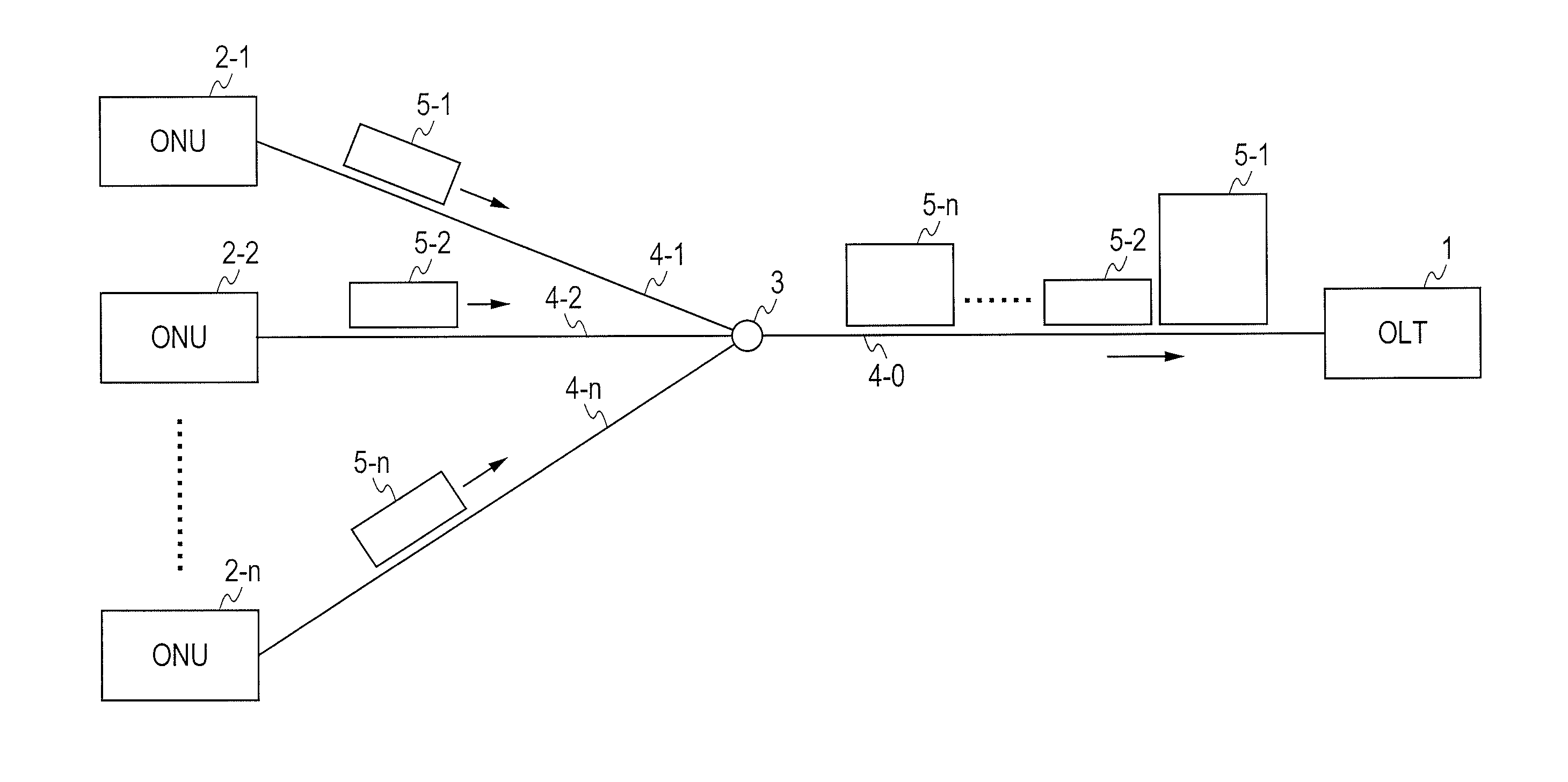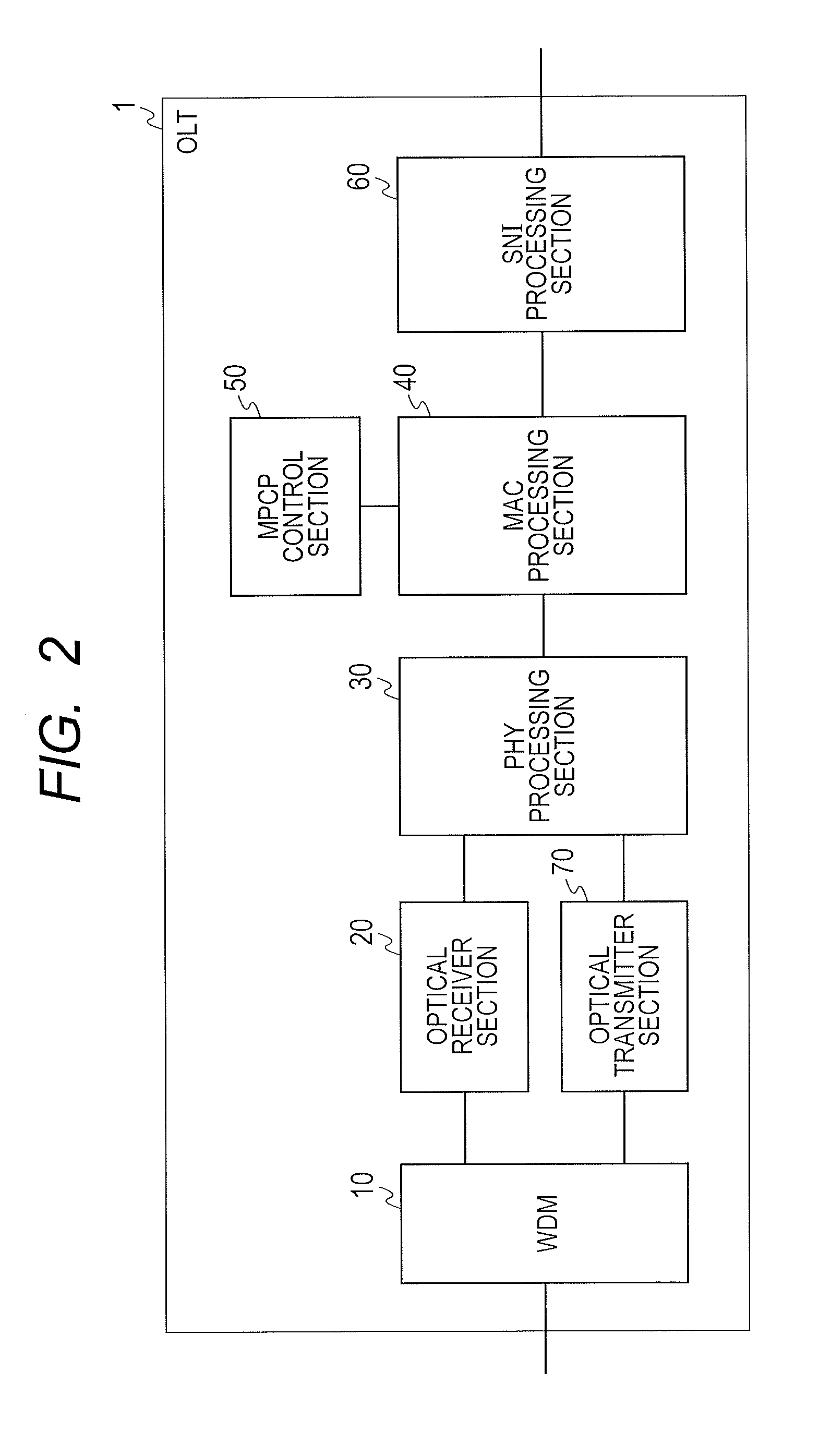Burst-Mode Receiver Equipped with Optical Amplifier, Method for Controlling Optical Amplifier, and System
a technology of optical amplifier and burst-mode receiver, which is applied in the field of optical receiver section equipped with optical amplifier, can solve the problems of limiting the range of optical strength that can be received, the dependence of the wavelength of each onu, and the inability to compensate the gain dependency, so as to keep the receivable range of the receiver in a wide state, the effect of polarization dependence and almost constant optical amplifier gain
- Summary
- Abstract
- Description
- Claims
- Application Information
AI Technical Summary
Benefits of technology
Problems solved by technology
Method used
Image
Examples
first embodiment
[Configuration of General PON System]
[0053]FIG. 1 shows a configuration of the optical access network using PON. The optical access network has OLT1, an optical splitter 3, and multiple ONU2's (2-1 to 2-n). The OLT1 is connected with the optical splitter 3 through optical fiber 4-0 that is of a trunk line. ONU2's (2-1 to 2-n) are connected to the optical splitter 3 through the optical fibers 4 (4-1 to 4-n) of branch lines, respectively. Uplink transmission to the OLT1 from ONU2's (2-1 to 2-n) will be explained. The optical signals that ONU2's sent out are multiplexed by the optical splitter 3. The multiplexed optical signal is inputted into the OLT1. The distance between ONU2 and the OLT1 differs for every ONU. Moreover, since the optical signal attenuates as the distance increases, the optical signal inputted into the OLT1 becomes a burst signal whose strength varies.
[Configuration of General OLT]
[0054]FIG. 2 shows a configuration of an OLT1 device. The OLT1 includes a WDM 10, an o...
second embodiment
[0090]Next, a second embodiment of the present invention will be described. The explanation will be given focusing on a difference with respect to the first embodiment. In the second embodiment, the optical receiver section has a variable attenuator, and an amount of attenuation of the variable attenuator is adjusted for every transmission wavelength of the ONU.
[Configuration of Optical Receiver Section in the Second Embodiment]
[0091]A configuration of an optical receiver section in a second embodiment will be explained using FIG. 14. Differences with respect to the first embodiment exist in a point of having a variable attenuator 212 and a point that an optical amplifier control section 242 can control the amount of attenuation of the variable attenuator 212.
[0092]The variable attenuator 212 attenuates the optical signal that was inputted from the optical amplifier 210 based on the amount of attenuation directed by the optical amplifier control section 242, and outputs the attenuat...
third embodiment
[0100]Next, a third embodiment of the present invention will be described. The explanation will be given focusing on a difference with respect to the first embodiment. In the third embodiment, instead of negating the need for the ONU wavelength management section, a wavelength detection section is provided, a wavelength is detected from the received optical signal, and the injection current of the optical amplifier is adjusted based on the detected wavelength.
[Configuration of Optical Receiver Section in the Third Embodiment]
[0101]FIG. 16 shows a configuration of an optical receiver section 20 in the third embodiment of the present invention. Differences with respect to the first embodiment are a point of not having the ONU wavelength management section and a point of having an optical splitter 280, an optical spectrum detector 281, and a wavelength detection section 282. Moreover, this configuration includes an optical amplifier control section 243 and an MPCP control section 52 th...
PUM
 Login to View More
Login to View More Abstract
Description
Claims
Application Information
 Login to View More
Login to View More - R&D
- Intellectual Property
- Life Sciences
- Materials
- Tech Scout
- Unparalleled Data Quality
- Higher Quality Content
- 60% Fewer Hallucinations
Browse by: Latest US Patents, China's latest patents, Technical Efficacy Thesaurus, Application Domain, Technology Topic, Popular Technical Reports.
© 2025 PatSnap. All rights reserved.Legal|Privacy policy|Modern Slavery Act Transparency Statement|Sitemap|About US| Contact US: help@patsnap.com



